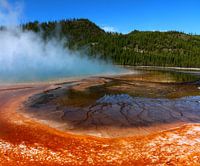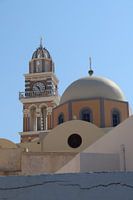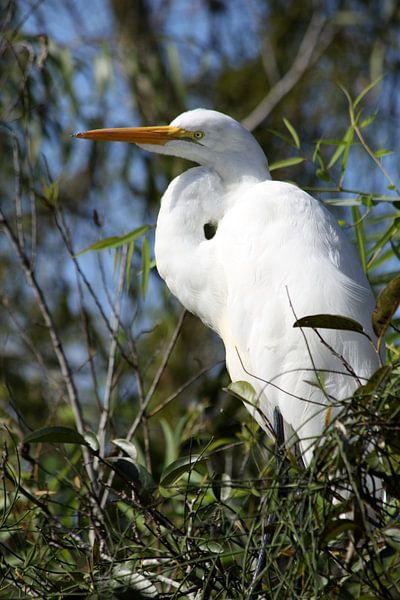Buy this bird art Silver Heron by Christiane Schulze on canvas, ArtFrame, poster and wallpaper, printed on demand in high quality.
About "Silver Heron"
by Christiane Schulze
About the artwork
Copyright: Christiane Schulze
The Great White Egret (Ardea alba, Syn.: Casmerodius albus, Egretta alba) belongs to the family of herons of the order Pelecaniformes. Four subspecies are distinguished.
The species has a very large distribution area, covering large parts of Eastern and Southern Europe, North, Central and South America, Asia and Africa. In Central Europe the Great White Egret is a locally distributed and common breeding and annual bird. The species shows a pronounced tendency to migrate and is also increasingly observed in regions of Central Europe where it is not a breeding bird.
An egret is any of several herons, most of which are white or buff, and several of which develop fine plumes (usually milky white) during the breeding season. Many egrets are members of the genera Egretta or Ardea which also contain other species named as herons rather than egrets. The distinction between a heron and an egret is rather vague, and depends more on appearance than biology. The word "egret" comes from the French word "aigrette" that means both "silver heron" and "brush," referring to the long filamentous feathers that seem to cascade down an egret's back during the breeding season.
The great zilverreiger (Ardea alba) is a white bird from the family of reigers. Voorheen considers the bird to be Egretta alba (Linnaeus, 1758) or Casmerodius albus.

About Christiane Schulze
All Artwork is Registered and Orginal Artwork of Christiane Schulze.
All rights Reserved and Copyrighted to Christiane W. Schulze and protected
by US and International Copyright Law.
Copying and/or distributing these images without my permission is strictly prohibited.
Christiane W. Schulze was born in Dortmund / Germany
From 2003 - 2007 she studied Art.
Since 2007..
Read more…
 Germany
Germany Ordered in September 2019
Ordered in September 2019
 Germany
Germany Ordered in March 2022
Ordered in March 2022
 Germany
Germany Ordered in March 2021
Ordered in March 2021
 Germany
Germany Ordered in February 2022
Ordered in February 2022
 Germany
Germany Ordered in April 2021
Ordered in April 2021
 Germany
Germany Ordered in April 2022
Ordered in April 2022
 Germany
Germany Ordered in November 2020
Ordered in November 2020
 Germany
Germany Ordered in May 2021
Ordered in May 2021
 Netherlands
Netherlands Ordered in May 2020
Ordered in May 2020
 Netherlands
Netherlands Ordered in March 2024
Ordered in March 2024
 Germany
Germany Ordered in September 2020
Ordered in September 2020
 Germany
Germany Ordered in July 2022
Ordered in July 2022
About the material
ArtFrame™
Interchangeable Art Prints
- High-quality print
- Easily interchangeable
- Acoustic function
- Large sizes available
Discover the artworks of Christiane Schulze
 Summer day At Sylvian Lake North DakotaChristiane Schulze
Summer day At Sylvian Lake North DakotaChristiane Schulze Breathtakingly beautifulChristiane Schulze
Breathtakingly beautifulChristiane Schulze The whole beauty of natureChristiane Schulze
The whole beauty of natureChristiane Schulze Icon of Central Park - The Bow BridgeChristiane Schulze
Icon of Central Park - The Bow BridgeChristiane Schulze Sunset over Venice Beach in black and whiteChristiane Schulze
Sunset over Venice Beach in black and whiteChristiane Schulze Gelbe Taxen auf Ocean Drive MiamiChristiane Schulze
Gelbe Taxen auf Ocean Drive MiamiChristiane Schulze Crater Lake und Wizard IslandChristiane Schulze
Crater Lake und Wizard IslandChristiane Schulze Cape Meares LighthouseChristiane Schulze
Cape Meares LighthouseChristiane Schulze reflected beautyChristiane Schulze
reflected beautyChristiane Schulze Des Sommers schöne SeiteChristiane Schulze
Des Sommers schöne SeiteChristiane Schulze A Sweet Face - Linocut a la PicassoChristiane Schulze
A Sweet Face - Linocut a la PicassoChristiane Schulze Grand Prismatic SpringChristiane Schulze
Grand Prismatic SpringChristiane Schulze Birches in springChristiane Schulze
Birches in springChristiane Schulze Steamship SchaarhörnChristiane Schulze
Steamship SchaarhörnChristiane Schulze Lightship Elbe 1Christiane Schulze
Lightship Elbe 1Christiane Schulze Dome and bell tower in Thira - SantoriniChristiane Schulze
Dome and bell tower in Thira - SantoriniChristiane Schulze The ElbphilharmonieChristiane Schulze
The ElbphilharmonieChristiane Schulze Ornamental garlic flowersChristiane Schulze
Ornamental garlic flowersChristiane Schulze Spring in the ArboretumChristiane Schulze
Spring in the ArboretumChristiane Schulze Peony DelightChristiane Schulze
Peony DelightChristiane Schulze













 Birds
Birds Florida
Florida North America
North America Photo wallpaper
Photo wallpaper Photography
Photography Serene Peace
Serene Peace









